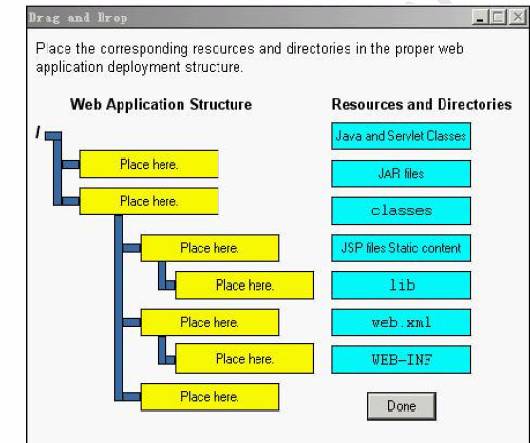Page: 4
2. The Structure and Deployment of Web Applications
Q15. Which two are true regarding a web application class loader?
(Choose two.)
A. A web application may override the web container's implementation classes.
B. A web application running in a J2EE product may override classes in the javax.* namespace.
C. A web application class loader may NOT override any classes in the java.* and javax.* namespaces.
D. Resources in the WAR class directory or in any of the JAR files within the library directory may be accessed using the J2SE semantics of getResource.
E. Resources in the WAR class directory or in any of the JAR files within the library directory CANNOT be accessed using the J2SE semantics of getResource.
Answer: C, D
Q16. Click the Task button.
Place the corresponding resources and directories in the proper web application deployment structure.

Answers:
Q17. You want to create a valid directory structure for your Java EE web application, and you want to put your web application into a WAR file called MyApp.war. Which two are true about the WAR file? (Choose two.)
A. At deploy time, Java EE containers add a directory called META-INF directly into the MyApp directory.
B. At deploy time, Java EE containers add a file called MANIFEST.MF directly into the MyApp directory.
C. It can instruct your Java EE container to verify, at deploy time, whether you have properly configured your application's classes.
D. At deploy time, Java EE containers add a directory call META-WAR directly into the MyApp directory.
Answer: A, C
Q18. Which two from the web application deployment descriptor are valid?(Choose two.)
A. <error-page>
<exception-type>*</exception-type>
<location>/error.html</location>
</error-page>
B. <error-page>
<exception-type>java.lang.Error</exception-type>
<location>/error.html</location>
</error-page>
C. <error-page>
<exception-type>java.lang.Throwable</exception-type>
<location>/error.html</location>
</error-page>
D. <error-page>
<exception-type>java.io.IOException</exception-type>
<location>/error.html</location>
</error-page>
E. <error-page>
<exception-type>NullPointerException</exception-type>
<location>/error.html</location>
</error-page>
Answer: C, D
Q19. After a merger with another small business, your company has inherited a legacy WAR file but the original source files were lost. After reading the documentation of that web application, you discover that the WAR file contains a useful tag library that you want to reuse in your own webapp packaged as a WAR file.What do you need to do to reuse this tag library?
A. Simply rename the legacy WAR file as a JAR file and place it in your webapp's library directory.
B. Unpack the legacy WAR file, move the TLD file to the META-INF directory, repackage the whole thing as a JAR file, and place that JAR file in your webapp's library directory.
C. Unpack the legacy WAR file, move the TLD file to the META-INF directory, move the class files to the top-level directory, repackage the whole thing as a JAR file, and place that JAR file in your webapp's library directory.
D. Unpack the legacy WAR file, move the TLD file to the META-INF directory, move the class files to thetop-level directory, repackage the WAR, and place that WAR file in your webapp's WEB-INF directory.
Answer: C
Page: 4
1
2
3
4
5
6